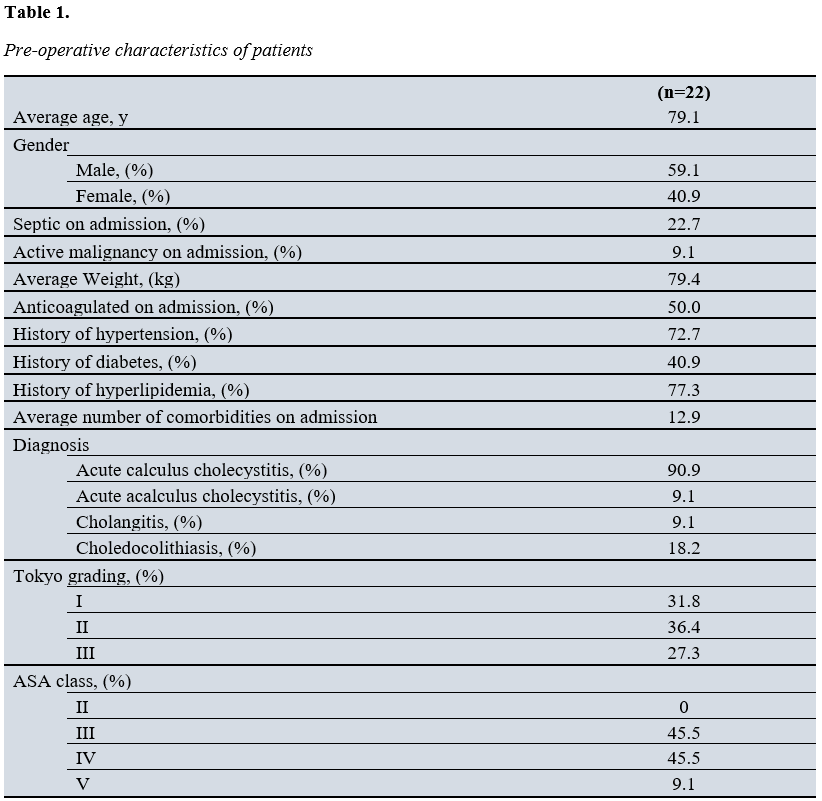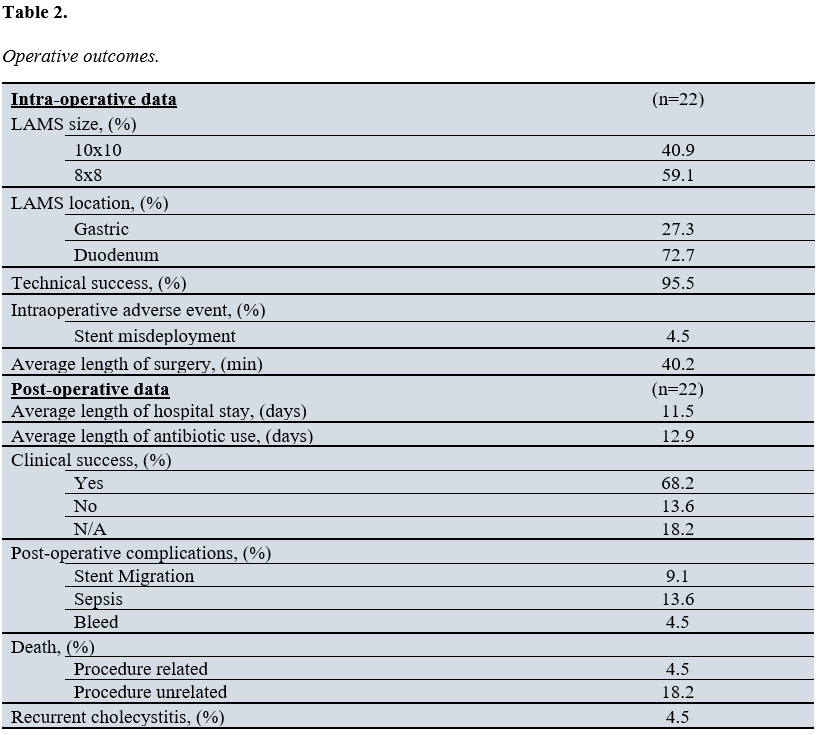Sunday Poster Session
Category: Biliary/Pancreas
P0039 - Clinical Outcomes of Axios Stent Placement for Gallbladder Drainage: A Case Series
Sunday, October 26, 2025
3:30 PM - 7:00 PM PDT
Location: Exhibit Hall

Aziz Eshov, DO (he/him/his)
Skagit Regional Hospital
Arlington, AR
Presenting Author(s)
Aziz Eshov, DO1, Jordan King, 2, Jayanta Datta, 3, Samit Datta, MD4
1Skagit Regional Hospital, Arlington, WA; 2Pacific NorthWest University College of Osteopathic Medicine, Mount Vernon, WA; 3The Ohio State University, Columbus, OH; 4Skagit Regional Hospital., Mount Vernon, WA
Introduction: Endoscopic ultrasound guided gallbladder drainage (EUS-GB) with a lumen apposing metal stent (LAMS) is a procedure aimed at patients with acute cholecystitis (AC) who are non-surgical candidates. With high clinical success, it is considered a safe alternative to percutaneous drainage (PTC). We present a case series evaluating efficacy of LAMS in a community hospital setting.
Methods: This retrospective case series involved chart review of patients who underwent EUS-GBD via hot LAMS between 3/2023 and 5/2025. All patients were deemed non-surgical candidates. Procedures were performed by a single experienced interventional gastroenterologist at a Level II community hospital. Data were categorized into preoperative assessments and procedural outcomes. Technical success was defined as successful deployment of the LAMS. Clinical success was defined as symptomatic improvement within one month of stent placement.
Results: All patients included in the study were classified as ASA of III or higher (Table 1). Patients received either transduodenal (72.7 %) or transgastric (27.3 %) LAMS placement. Technical success was achieved in 95.5 % of cases (Table 2). Clinical success was observed in 68.2 % of the cohort (Table 2). Reported post-procedural complications included stent migration (9.1 %), sepsis (13 %), and gastrointestinal bleeding (4.5 %). Post-procedural mortality rate was 22.7 %; however, only one death (4.5 %) was attributed to a procedure-related complication. Recurrent cholecystitis occurred in a 1 patient (4.5 %).
Discussion: Cholecystectomy remains the standard of care for the management of AC. For non-surgical candidates, current clinical guidelines primarily recommend PTC. However, emerging evidence has demonstrated that EUS-GBD offers high clinical success rates, along with a lower incidence of adverse events. In this case series, we observed a clinical success rate of 68 % in the management of AC using EUS-GBD. Patients who died within 30 days of the procedure were treated as clinical failures since data could not be collected; however, only one of these deaths was presumed to be related to post-procedural complications. The remaining fatalities were considered unrelated to the intervention and were attributed to underlying comorbidities. Notably, all patients who underwent LAMS placement were critically ill and considered to be at high acuity, with EUS-GBD employed as a salvage therapy in an attempt to manage their condition.

Figure: Characteristics of patients on admission to the hospital prior to receiving trans-enteric biliary drainage.

Figure: Intra-procedural and post-procedural LAMS placement outcomes.
Disclosures:
Aziz Eshov indicated no relevant financial relationships.
Jordan King indicated no relevant financial relationships.
Jayanta Datta indicated no relevant financial relationships.
Samit Datta indicated no relevant financial relationships.
Aziz Eshov, DO1, Jordan King, 2, Jayanta Datta, 3, Samit Datta, MD4. P0039 - Clinical Outcomes of Axios Stent Placement for Gallbladder Drainage: A Case Series, ACG 2025 Annual Scientific Meeting Abstracts. Phoenix, AZ: American College of Gastroenterology.
1Skagit Regional Hospital, Arlington, WA; 2Pacific NorthWest University College of Osteopathic Medicine, Mount Vernon, WA; 3The Ohio State University, Columbus, OH; 4Skagit Regional Hospital., Mount Vernon, WA
Introduction: Endoscopic ultrasound guided gallbladder drainage (EUS-GB) with a lumen apposing metal stent (LAMS) is a procedure aimed at patients with acute cholecystitis (AC) who are non-surgical candidates. With high clinical success, it is considered a safe alternative to percutaneous drainage (PTC). We present a case series evaluating efficacy of LAMS in a community hospital setting.
Methods: This retrospective case series involved chart review of patients who underwent EUS-GBD via hot LAMS between 3/2023 and 5/2025. All patients were deemed non-surgical candidates. Procedures were performed by a single experienced interventional gastroenterologist at a Level II community hospital. Data were categorized into preoperative assessments and procedural outcomes. Technical success was defined as successful deployment of the LAMS. Clinical success was defined as symptomatic improvement within one month of stent placement.
Results: All patients included in the study were classified as ASA of III or higher (Table 1). Patients received either transduodenal (72.7 %) or transgastric (27.3 %) LAMS placement. Technical success was achieved in 95.5 % of cases (Table 2). Clinical success was observed in 68.2 % of the cohort (Table 2). Reported post-procedural complications included stent migration (9.1 %), sepsis (13 %), and gastrointestinal bleeding (4.5 %). Post-procedural mortality rate was 22.7 %; however, only one death (4.5 %) was attributed to a procedure-related complication. Recurrent cholecystitis occurred in a 1 patient (4.5 %).
Discussion: Cholecystectomy remains the standard of care for the management of AC. For non-surgical candidates, current clinical guidelines primarily recommend PTC. However, emerging evidence has demonstrated that EUS-GBD offers high clinical success rates, along with a lower incidence of adverse events. In this case series, we observed a clinical success rate of 68 % in the management of AC using EUS-GBD. Patients who died within 30 days of the procedure were treated as clinical failures since data could not be collected; however, only one of these deaths was presumed to be related to post-procedural complications. The remaining fatalities were considered unrelated to the intervention and were attributed to underlying comorbidities. Notably, all patients who underwent LAMS placement were critically ill and considered to be at high acuity, with EUS-GBD employed as a salvage therapy in an attempt to manage their condition.

Figure: Characteristics of patients on admission to the hospital prior to receiving trans-enteric biliary drainage.

Figure: Intra-procedural and post-procedural LAMS placement outcomes.
Disclosures:
Aziz Eshov indicated no relevant financial relationships.
Jordan King indicated no relevant financial relationships.
Jayanta Datta indicated no relevant financial relationships.
Samit Datta indicated no relevant financial relationships.
Aziz Eshov, DO1, Jordan King, 2, Jayanta Datta, 3, Samit Datta, MD4. P0039 - Clinical Outcomes of Axios Stent Placement for Gallbladder Drainage: A Case Series, ACG 2025 Annual Scientific Meeting Abstracts. Phoenix, AZ: American College of Gastroenterology.
